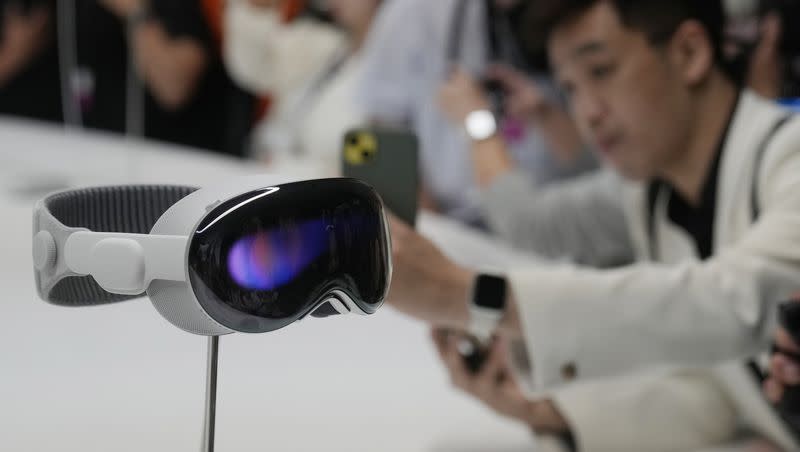Opinion: Will Apple’s Vision Pro be a boon or society’s doom?

One scene in Apple’s promotional video for its new Vision Pro “spatial computing” headset made me at least virtually willing to pay the $3,500 to own one.
I said “virtually,” as in, with a make-believe wallet I don’t really own.
The scene is of a woman sitting on her bed, using her laptop and wearing the device. She closes the laptop, reclines on the mattress and looks at her ceiling which, through the lens in her headset, magically transforms into a blue sky with wispy white clouds, as real as a summer’s day.
Who wouldn’t want to be able to lie down in a warm park and stare at a blue sky anytime one chooses — say, on a snowy winter night or in an unfamiliar hotel room — and drift to sleep amid the chirping of birds?
Except, of course, that, like everything else about the crack-cocaine-addiction level of smartphones and virtual reality, it wouldn’t be real. It might or might not be dangerously unreal — depending on the experts you believe — but it would certainly remove us one step further from everything that is real.
When Steve Jobs unveiled the iPhone in 2007, few people understood what was about to happen to the world. I have long been convinced that, one day, people will laugh at photos from the early 21st century because everyone in the background has his or her head down, staring at a mobile device.
I just didn’t think that when that era ended, it would be because we would look up and around us, not enjoying the beauties of the real world, but of a make-believe one only we could see.
Of course, this depends on Vision Pro becoming more than just a modern version of Google Glass, this generation’s Edsel.
Related
But the idea seems so intriguing — you can turn any room into a movie theater and make your virtual screen appear 100 feet wide — that the technology is bound to get better and more compact. One day, it may all be in a simple pair of glasses, or in contact lenses.
If you haven’t seen Vision Pro, you should check it out. It could be the future we both dream about and dread.
That’s the trouble with new technology, from virtual reality to chatGPT. They present ideas so appealing they are hard to resist. They also are good. Who would deny that we’re better off today with the world in our pockets than we were when phones were attached to walls?
And yet, they are good only in moderation, a concept harder and harder to embrace as we become mesmerized by ever-flashier features. They may even create problems we can’t foresee.
Anna Lembke, a professor of psychiatric and behavioral sciences at Stanford University, recently told wired.com, “We need to come up with a kind of cultural etiquette around what appropriate and healthy consumption is, just like we have for other consumptive problems.” She mentioned no-smoking zones, alcohol laws, age-limits for casinos and how, “We don’t eat ice cream for breakfast” (speak for yourself!).
The problem is, I don’t see anyone establishing any new etiquettes in an age when so many old etiquettes (how to dress for weddings or funerals, sending thank-you cards, etc.) are disappearing.”
As Molly Roberts wrote in The Washington Post, “Put the phone away at dinner, please, makes some sense. Remove the smart-contacts? No need.”
Instead, I find myself agreeing with John-Anthony Disotto, who wrote for iMore.com, “I don’t want to live in what I feel is moving towards a dystopia where we communicate through headsets. Will I have a choice?”
Apple calls this, “A profound new way to be together.” But what will we say about it 20 years from now?
Writing for Psychology Today, “digital health evangelist” John Nosta raised warnings about normalizing “the digital as part of our everyday reality” and blurring boundaries between what’s real and what’s simulated.
“It’s possible that as our experiences within these digital constructs grow richer and more authentic, the previous ‘human reality’ might indeed become obsolete, relegated to a vestigial status,” he wrote.
Already, studies are suggesting strong links between social media and depression and anxiety. What new problems may emerge from the overuse of spatial computing that blends the virtual world with reality?
One scene in that Vision Pro promotional video shows a father, looking like some sort of alien with goggles, smiling as he watches his children blow bubbles. He’s really taking 3D pictures of them through his headset.
I suppose some day he might smile while watching those photos and videos on a virtual 100-foot screen.
Or maybe he will wish he had ditched the headset, grabbed a soap bottle, gotten down on the floor and started blowing bubbles with them.

